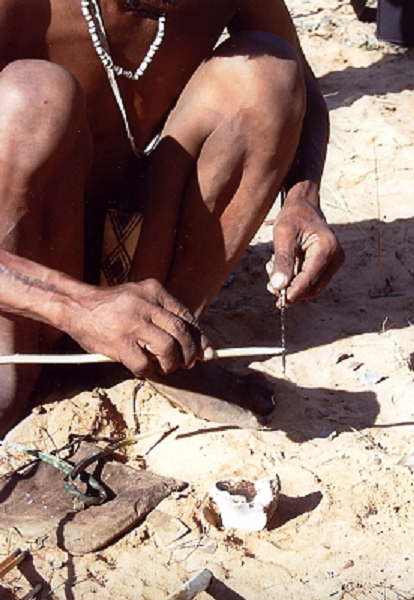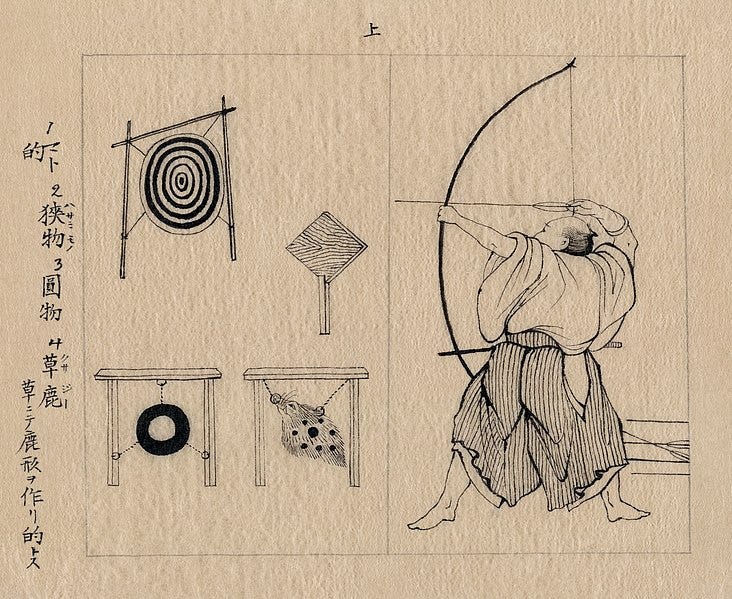# The Bow and Arrow: A Tool of Evolution, Philosophy, and Empire
Written on
Chapter 1: The Evolutionary Significance of Projectiles
The journey of human evolution has always intrigued scholars and enthusiasts alike. The transformation from tree-dwelling primates to the dominant species on Earth is a complex tale. While intelligence is often credited as a key factor, there are other elements to consider. One compelling argument is the role of throwing in our development.
Steve Steward-Williams, in his insightful work "The Ape That Understood The Universe," refers to humans as the “throwing ape.” He posits that our adeptness at throwing projectiles sets us apart from our primate relatives. Similarly, Professors Michael Lombardo and Robert Deaner from The Conversation highlight that:
“Humans are the only species capable of throwing with enough precision to take down rivals and hunt prey. This skill demands a remarkable level of coordination and rapid movement among multiple body parts, suggesting that there was a long evolutionary history favoring enhanced throwing abilities in our ancestors.”
This foundational skill, combined with intelligence, led to advancements in projectile technology over time. From the creation of spears to the development of tools that enhance spear-throwing, our ancestors discovered a transformative method for survival that would eventually elevate them in the food chain. This technology spread globally, becoming so ingrained that it was often depicted in philosophies and religions as a vehicle for imparting moral lessons.
Moreover, the bow and arrow, often viewed today as a mere sport, played a pivotal role in our evolution.
Section 1.1: Early Evidence of Bow Usage
The bow and arrow are not only symbols of advanced cognitive abilities but also indicators of complex human behavior. A study led by Lucinda Backwell and her team suggests that the earliest evidence of projectile use, such as spear points, dates back approximately five hundred thousand years. The more sophisticated bow and arrow, however, emerged much later.
In their research, Backwell's team uncovered a cylindrical bone fragment in the Sibudu Cave, located on South Africa's East Coast, believed to be around sixty-two thousand years old. Its structure closely resembles that of arrow points from the Later Stone Age. The fragment also exhibited signs of charring, likely due to its discovery in a hearth, and displayed characteristics indicating it was crafted with stone tools.
Backwell and her colleagues created replicas of the point from eland bones, giving six to a local San tribesman who fashioned them onto reeds with animal sinew. He then shot them using a homemade bow. Remarkably, the arrows penetrated a goat carcass from a distance of up to twenty-eight feet, and the team later analyzed the heads with advanced CT imaging.

They found that the charred replica exhibited similar stress fractures to the original, supporting its identification as a probable arrowhead. Other findings have also pointed to bow usage in Europe around fifty-four thousand years ago and in Sri Lanka, where bone arrow tips were dated at approximately forty-eight thousand years old.
Section 1.2: Archery as a Tool for Wisdom
Archery transcended mere survival; it evolved into a powerful means of imparting wisdom. Vineet Lalan, in an article for The Acropolitan Magazine, illustrates how the bow is a metaphor for humanity in ancient Indian philosophy. He recounts a narrative from the Mahabharata that uses archery to emphasize the importance of focus.
The Lakota Tribe also harnessed the bow as a teaching instrument. Author Joseph Marshall III shares how his grandfather used the bow to convey lessons about the balance between masculine and feminine energies. The bow represented femininity, while the arrow symbolized masculinity—together, they illustrated the harmony necessary for life.
Early Christian teachings similarly employed archery to convey moral lessons. The Greek term “hamartia,” meaning “to miss the mark,” serves as a metaphor for moral failures. John Sellars, a research fellow at King’s College London, notes that Stoic philosophers likened the ideal Stoic to an archer: focusing on the act of shooting rather than the outcome, which is often beyond one's control.
In Japan, archery serves as a spiritual exercise rather than merely a sport. Eugen Herrigel’s "Zen In The Art Of Archery" reveals how mastery of the bow leads to self-improvement, emphasizing that the true objective is not hitting a target but refining one’s form and mindset.

Chapter 2: The Bow as an Instrument of Conquest
The bow has been central to the nomadic tribes of the Eurasian Steppe, most notably exemplified by Genghis Khan. With a ragtag band of followers, he expertly combined archery, horsemanship, and organization into an empire that changed history.
According to Luvsannorov Munkh, an experimental archaeologist, the Mongolian bow of the thirteenth century epitomized three millennia of innovation. Munkh explains:
“It is a composite bow made from leather, horn, and wood, bound with animal sinew and coated in tree bark for protection against moisture.”
The Mongolian bows had remarkable range, capable of firing arrows nearly five hundred meters. Children were taught to ride horses at three and could wield a bow proficiently by age five, ensuring that by adulthood, they were masters of both skills.
In "Genghis Khan and the Quest For God," Jack Weatherford describes how the Mongol army was entirely cavalry, allowing for unparalleled mobility. Their archers became a formidable force, enabling the Mongol Empire to expand across nine million square miles at its zenith.
The bow represents a significant chapter in human evolution. While our cognitive development propelled us forward, the ability to throw and utilize projectiles greatly enhanced our survival and dominance in the food chain. It became a universal tool for not only practical survival but also for teaching profound philosophical concepts and aiding in empire-building.
Humanity is characterized by creativity, thoughtfulness, and resilience. Thus, the bow encapsulates our essence. It is more than just a pastime; it is a tangible representation of what it means to be human.
If you wish to explore more intriguing stories, consider signing up for my mailing list. For further engagement, feel free to visit my profile page.